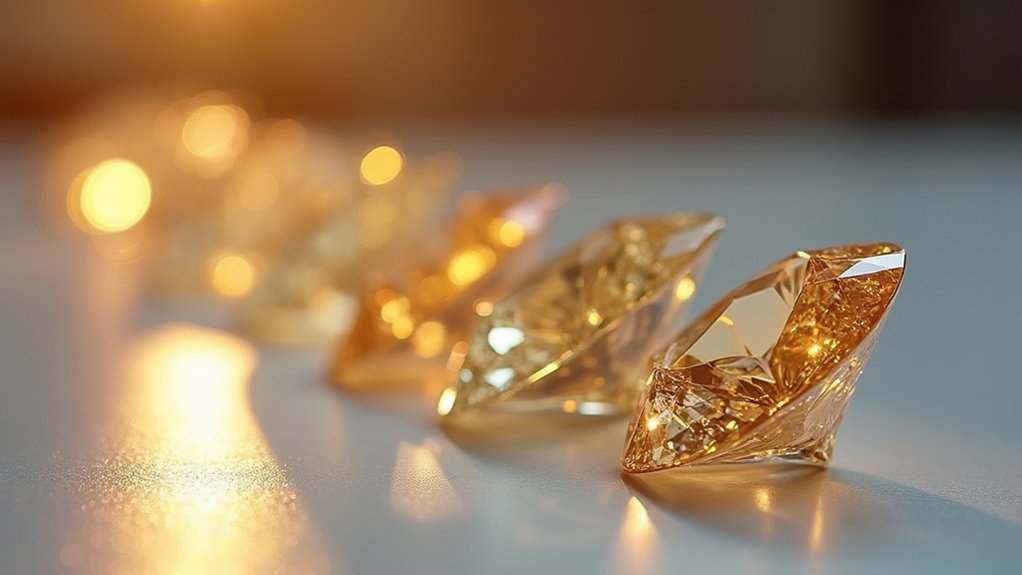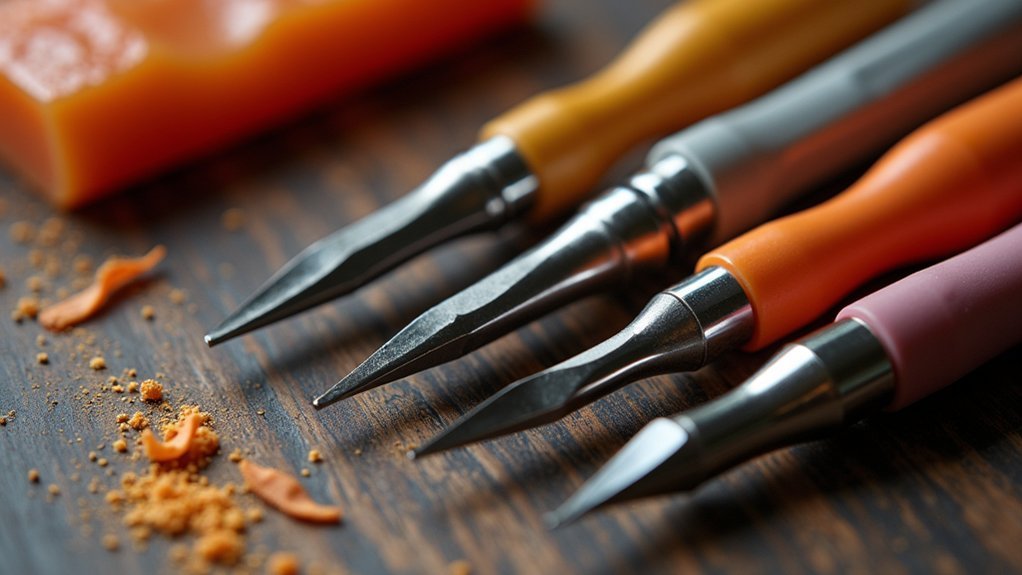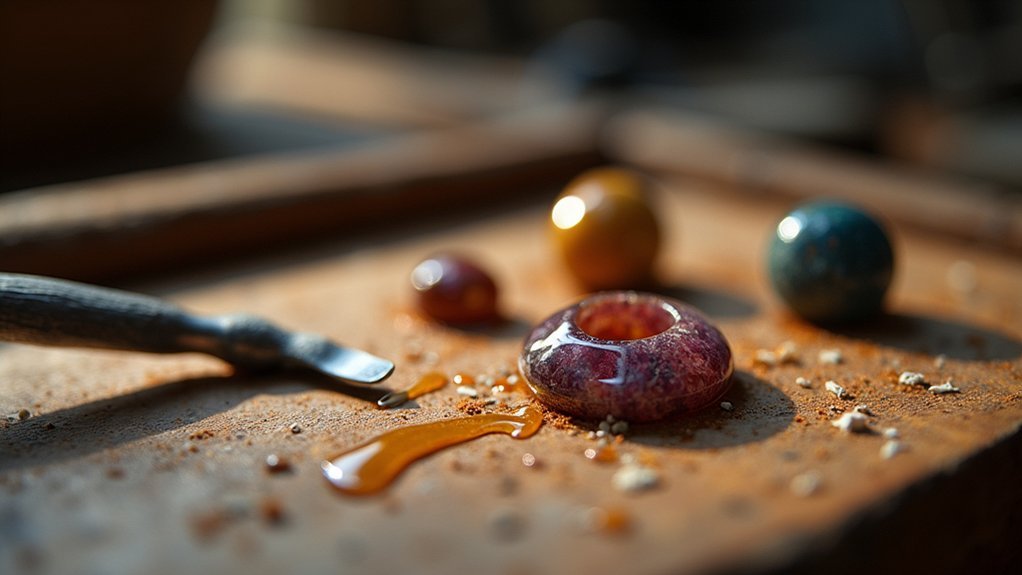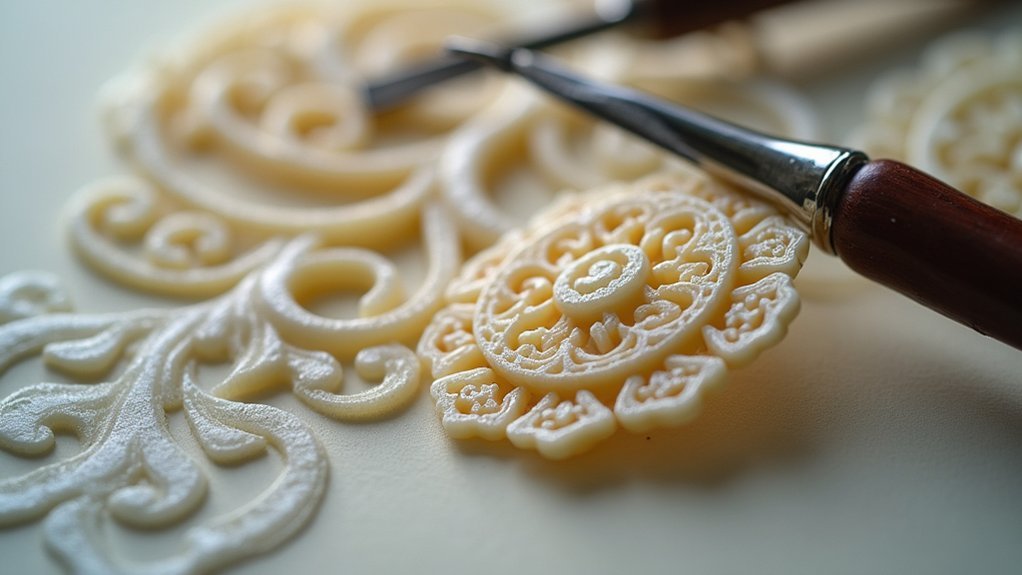The GIA D-Z diamond color scale ranges from colorless (D-F) to light yellow (N-Z), with near-colorless (G-J) and faint yellow (K-M) in between. You’ll notice significant price differences across grades, with G diamonds costing 30% less than D while appearing similarly white. Your setting choice affects color perception—white metals enhance colorless stones while yellow gold complements lower grades. The perfect diamond balances all 4Cs, not just color perfection.
The Evolution and Purpose of the GIA Color Scale

When the diamond industry lacked standardization in the 1940s, the Gemological Institute of America (GIA) stepped in to create the now-iconic color grading scale that revolutionized how we evaluate diamond quality.
This D-Z color scale established a reliable framework that transformed diamond color grading from subjective opinions to objective assessments.
You’ll notice the scale begins with “D” (not A) intentionally—GIA wanted to separate their system from previous inconsistent grading practices.
The scale progresses through 23 distinct grades from colorless diamonds at the highest end to those with noticeable light yellow, grey, brown, or pink tints.
This standardization has greatly enhanced consumer trust in diamond purchases by providing consistent language and evaluation criteria throughout the global diamond industry.
Understanding the D-Z Diamond Color Grading System
The GIA’s D-Z color grading system stands as a cornerstone of diamond assessment today. This thorough diamond color chart categorizes stones across 23 distinct grades, from the exceptionally rare and valuable colorless diamonds (D-F) to those with noticeable light yellow tint (K-Z).
When shopping for diamonds, you’ll find four main color quality categories: D-F (colorless), G-J (near colorless), K-M (faint yellow), and N-Z (very light to light yellow).
The Gemological Institute of America designed this grading scale to provide consistency and transparency in the marketplace. Expert gemologists determine each diamond’s precise color grade by comparing it with master stones under controlled lighting conditions.
Understanding the GIA color scale helps you make informed decisions about balancing color quality with your budget priorities.
Colorless vs. Near-Colorless: Visual Differences Explained

Although both categories appear ice-white to untrained eyes, colorless (D-F) and near-colorless (G-J) diamonds reveal subtle distinctions under proper examination. On the diamond color scale, these differences become apparent when stones are compared side by side.
G color diamonds offer exceptional value, costing 30% less than D color diamonds while maintaining a colorless appearance in most settings. H color diamonds may show faint yellow tint in bright light, particularly against white backgrounds.
| Grade | Category | Appearance | Setting Recommendation |
|---|---|---|---|
| D-F | Colorless | Ice-white | White gold/platinum enhances brilliance |
| G | Near-colorless | Appears colorless | White gold/platinum ideal |
| H | Near-colorless | Slight warmth | White or yellow gold suitable |
| I-J | Near-colorless | Visible warmth | Yellow gold complements color |
Your setting choice considerably impacts perceived color—platinum highlights colorlessness while yellow gold can complement warmer tones.
How Diamond Settings Influence Color Perception
Diamond settings play an essential role in how you perceive a stone’s color, often making as much difference as the actual color grade itself.
White metals like platinum and white gold enhance colorless diamonds, making them appear even more brilliant and icy.
Surprisingly, yellow gold can make lower color grade diamonds look whiter by creating contrast with the stone’s natural tint. This metal choice is particularly strategic for K-M diamonds, where the warm setting masks yellowish tones.
Your diamond’s cut matters too—round brilliant cuts hide color better than emerald cuts.
For maximum impact, consider a halo arrangement that can cleverly disguise any color imperfections in your center stone.
When selecting your perfect diamond, remember that visual perception is greatly influenced by the interplay between the stone and its setting.
Diamond Shapes and Their Effect on Color Visibility

Different diamond shapes greatly influence how color appears, with round brilliant cuts masking slight tints better than elongated shapes like emerald or marquise.
You’ll notice fancy shapes such as ovals and pears tend to display color more prominently, making it essential to take into account a higher color grade for these cuts.
Your setting choice can further enhance a diamond’s apparent color, potentially making a slightly lower color grade appear whiter when strategically mounted.
Shape Affects Color Perception
While searching for the perfect diamond, you’ll discover that shape greatly influences how color appears in your stone. Round brilliant cuts and princess cuts are excellent at masking color, making them ideal if you’re concerned about color visibility. Even at lower color grades, these shapes maintain impressive brilliance that can distract from any faint color tint.
In contrast, elongated shapes like oval or pear tend to show color more prominently. Emerald cuts, with their large, flat surfaces, make color particularly noticeable due to their step-cut faceting pattern. This is why higher color grades become more important when selecting fancy shapes.
Remember that diamond size also matters – larger stones display their true color more distinctly than smaller ones.
Understanding how shape affects color perception will help you make smarter choices within your budget.
Settings Enhance Color Grade
Just as an artist selects the perfect frame to highlight a painting, your choice of setting can dramatically enhance your diamond’s apparent color grade. The right setting creates an optical illusion that can make your diamond appear more colorless than its actual grade suggests.
- Metal choices matter – White gold and platinum settings make diamonds appear more colorless, while yellow gold settings can complement lower color grade diamonds by creating less contrast.
- Size considerations – Larger diamonds reveal color more prominently, so higher color grades become more important as carat weight increases.
- Strategic accent diamonds – Surrounding your center stone with slightly whiter accent diamonds can enhance the perceived color of your main diamond, creating an overall brighter appearance.
Your setting choice is as vital as the diamond itself for achieving that coveted colorless appearance.
Price Variations Across the Diamond Color Spectrum
The price of a diamond drops considerably as you move down the color grading scale, creating opportunities for savvy buyers to maximize value.
Savvy diamond shoppers can find exceptional value by exploring options further down the color grading scale.
Colorless diamonds (D-F) command premium prices due to their exceptional rarity, while near-colorless diamonds in the G-J color grade offer roughly 30% savings yet still appear colorless to untrained eyes.
For greater affordability, consider the K-M range, where the slight yellow tint translates to notably lower prices.
Remember that visible color becomes more pronounced as carat weight increases, so you might prioritize a higher color grade for larger stones.
Don’t focus solely on achieving the highest color grade—other factors like cut and clarity dramatically influence pricing within the same color category.
Even N-Z color diamonds can be suitable options when budget is your primary concern.
Comparing Color Grades: Expert Tips for Optimal Selection

How can you determine which diamond color grade delivers the best value for your investment? Near-colorless diamonds in the G to H color range offer excellent value, costing about 30% less than D color grades while maintaining visual appeal.
- Consider your diamond cut – Round brilliants mask color better than emerald or fancy shapes, allowing you flexibility in selecting lower color grades without compromising appearance.
- Match with setting metals – Your diamond setting can enhance color appearance; yellow gold makes lower grades like K or L appear whiter, while platinum highlights the true diamond color grading.
- Evaluate subtle color differences – Most people can’t detect differences between adjacent grades (like G vs H) without direct comparison, so prioritize balancing all 4Cs for ideal selection rather than obsessing over minor color variations.
Frequently Asked Questions
Can Color Grading Be Affected by Fluorescence in Diamonds?
Yes, fluorescence can affect how you see a diamond’s color. It’s common for blue fluorescence to mask yellow tints in diamonds with lower color grades, making them appear whiter under UV light.
How Do Fancy Colored Diamonds Fit Into the D-Z Scale?
Fancy colored diamonds don’t fit into the D-Z scale. They’re graded using a separate system that measures their hue, tone, and saturation. You’ll find they have their own classifications like “Fancy Vivid” or “Fancy Intense.”
Does Diamond Color Grade Change Over Time or With Wear?
No, your diamond’s color grade won’t change over time or with wear. The color is intrinsic to the diamond’s structure. However, dirt or scratches might make it appear slightly different until properly cleaned.
How Do Lab-Grown Diamonds Compare in Color Grading?
Lab-grown diamonds follow the same D-to-Z color grading scale as natural diamonds. You’ll find they’re available in all the same color grades and can’t be distinguished visually from mined diamonds of equivalent quality.
Can Home Testing Kits Accurately Determine Diamond Color Grades?
Home testing kits can’t accurately determine diamond color grades. They’re too imprecise compared to professional equipment used by gemologists. You’ll need a certified lab evaluation for reliable color grading of your diamonds.
In Summary
You’ve now mastered the diamond color grading scale—from the prestigious colorless D grade to the slight yellow tint of Z. Remember, settings can mask color, and some shapes show tint more readily than others. When shopping, you’ll find sweet spots where you can save money without sacrificing appearance. Trust your eyes, consider your preferences, and you’ll find the perfect balance of quality and value.





Leave a Reply